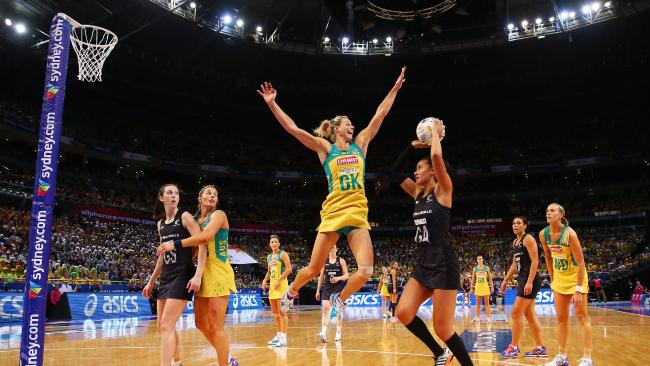By Zoe Rippon
Netball is the most common female team sport played in Australia and New Zealand. The elite professional netball league (ANZ championship) includes 10 teams across Australia and New Zealand. The high physical demands of the sport from sprinting, maximal jump landing (often with contact), change of direction and the rules only allowing one step after landing with the ball causes a significant risk of knee injuries to athletes. Between 2008 and 2015 Stuelcken et al, [1] found 21 athletes tore their anterior cruciate ligament (ACL) despite multiple screening tools and prevention measures in place to reduce the risk of these injuries. These injuries were sustained by either indirect contact (landing following a collision), non-contact (landing with no contact) or changing directions. ACL ruptures are still happening at an alarming rate with five female athletes nameable from the 2015/2016 campaign requiring ACL reconstructive surgery.

Could this be a training load issue? [2]
Training load is important to consider due to the competitive mentality of athletes to be the best; training harder and longer will enable them to perform better. This training mentality often pushes athletes to extreme physical limits. Overloading does not only cause overuse injuries; it is thought to contribute to acute soft tissue injuries as well. [2] Gabbett 2016, [2] describes the ‘Training-Injury Prevention Paradox’ established from current evidence that non-contact soft tissues injuries are a result of an incorrect training regimes. His research states that consistent loading from training has a reduced risk of injury of less than 10% (based on extrinsic factors (GPS) or intrinsic factors (rateable perceived value)) if training load was 5% less or 10% more than the previous week. Injury risk increased rapidly to between 21% and 49% If the load increased by 15% or more.
![Figure 1: Ratio of acute:chronic training load. Acute = is recent training load. Chronic = moderate-term training load. Green area where reduced injury risk where acute training load is graduated at 0.8-1.3 of the chronic training load. [2]](https://blogs.bmj.com/bjsm/files/2016/11/netball-graph.png)
The non-contact nature of these injuries leads to the questions: does overloading of the ACL in netball via the sudden deceleration mechanism during a running, jump, land and stop add to the high incident of ACL ruptures? Is there micro trauma/weakening or even previous partial tears that are undetected that make individuals prone to the ACL rupture? Does inappropriate loading lead to fatigue of the hip muscles, trunk muscles and/or hamstrings and then cause a high strain on the ACL? [1,3,4] Does mental fatigue have an effect on neuromuscular control? [5] It’s not as if we can pre-scan the ACL or do testing just before the injury to answer our questions and therefore we rely on documentation of the injuries including their mechanism. There are plenty of questions and not many clear answers. What we can establish from the literature is that the contributing factors are multifactorial. [1]
For minimising ACL injury risk we also need to take into account other factors that affect load on the netball athletes: [6]
- Age of the athlete
- Individual factors – biomechanics, neuromuscular control, BMI, physiological systems, psychological factors (confidence, determination)
- Equipment – netball shoes, floor surface (grip and shock absorption)
- Position on the netball court – requires different amounts of jumping, landing and running
- Level of the athlete e.g. development, experienced, length of time in team
- Athletes who play more than one sport
- Nutrition and recovery methods
The million-dollar question – what is the optimal training load for our netball athletes?
Optimal training loads are challenging to research and compare. Athletes or Coaches at the elite level do not want to share their information as possibly this is what gives them the edge over their competitors. Getting the load of training right not only reduces the athlete’s injury risk it also maximises their ability to perform. Reduction in injuries allows for maximal training and game time and more athletes available for competition. [2]
ACL injuries don’t just happen at the elite level, this is right through from juniors, recreational players, up (but aren’t well documented at these other levels). From my experience playing at a premier club level, the focus is on movement patterns and strength, but based on the Training-Injury Prevention Paradox model we need to start educating coaches and players on load management and appropriate training principles if we want to minimise non-contact injury risk further. [2] This training principle not only applies to preseason training and in season training and games, we can also use it to guide rehabilitation and a safe return to sport.
************************
Zoe Rippon is a Postgraduate student in sports physiotherapy at the University of Otago. She has an interest in netball injuries and prevention being a player herself. She also works in Private Practice at Muscle People Physiotherapy, Christchurch, New Zealand.
E-mail: zoerippon@gmail.com
References
1 Stuelcken M, Mellifont D, Gorman A, et al. Mechanisms of anterior cruciate ligament injuries in elite women’s netball: a systematic video analysis. J Sports Sci 2016;34:1516-1522. doi: 10.1080/02640414.2015.11211285 [published Online First: 8 December 2015].
2 Gabbett T. The training-injury prevention paradox: should athletes be training smarter and harder? Br J Sports Med 2016;50:273-280. Doi:10.1136/bjsports-2-15-095788 [published Online First: 12 January 2016].
3 Guelich D, Xu D, Koh J, et al. Different roles of the medial and lateral hamstrings in unloading the anterior cruciate ligament. The Knee 2016;23:97-101. doi: 10.1016/j.knee.2015.07.007 [published Online First: 6 August 2015].
4 Bossuyt F, Garcia-Pinillos F, Raja Azidin R, et al. The utility of a high intensity exercise protocol to prospectively assess ACL injury risk. Int J Sports Med 2016;37:125-133 doi: http://dx.doi.org/ 10.1055/s-0035-1555930 [published Online First: 28 October 2015].
5 Halson S. Monitoring training load to understand fatigue in athletes. Sports Med 2014;44:S139-S147 doi: 10.1007/s40279-014-0253-z [published Online First: 9 September 2014].
6 McGrath A, Ozanne-Smith J. Attacking the goal of netball injury prevention: a review of the literature. Monash University Accident Research Centre 1998:1-105 https://www.monash.edu/__data/assets/pdf_file/0004/217426/muarc130.pdf (assessed: 24 September 2016).